This is a terrific thread. I have often wondered about this myself, and I am glad to see that it is a question that many others (who know more than I do) have.
I like alot of what Jean just said, and feel that I am basically elaborating.
There is something I would like to note here, and that is there a discernable sweep of time and geography that we see with these weapon classes, and their definitions.
I think this is another example similiar to the thread from before Christmas where the definition of "rapier" got an examination.
Falchions seem to be an infantry weapon of relatively early period, but I would like to call to consideration how they seem to decline in prominence as medieval times turn to the renaissance. It seems as though the Messer has greater longevity, particularly from the German speaking areas heading East.
I would like to make the contention that England, France, and the states of Italy professionalized their militaries to the point that a poor-man's chopper was an obsolete piece of equipment compared to what the organized military was capable of issuing. I recognize what Jean noted about how Falchions evolved into other weapon types like the Dussack, etc. I think that if we were to do Oakeshott style classification of this weapon type, we would have to make a distinction between the early types, and the latter--something that can show the evolution from Saex to "golden age" falchion to Dussack/Schwiezersabel.
I think that this organization and professionalization of units did not happen at the same rate in the areas that used Messers, and it stayed in service far longer as a result, partly from military unit organization, possibly from the warrior ethos of the culture which seemed to value this weapon.
I know this sounds long winded, but I think the definitions/differences of these weapons is less about characteristics, and more about how particular pieces fall on a certain arc or continuum.
| Jean Thibodeau wrote: |
|
Thanks again for all the research. :cool: One way I look at things is to forget what it's called, was called, disputes about what we call them and just look at these things as form follows function: All the choppers, falchions, messers are related as far as how they would function and would be used. |
Jean,
I agree; I think form and function are more important than the term we tack onto a weapon. Most of these falchions, choppers, and messers seem to have worked in a similar way. They seem to have been designed to deliver a devastating cut/chop, sort of the "meat cleaver effect", if you will. This is just a generalization, and there were many variations of the basic design.
However, I think the study of what they may have actually called these things can be interesting, as well as a bit frustrating at times. There are many, many arms and armour terms used just in the historical records of medieval Europe (just take a peek at the glossary in the back of Nicolle's Arms & Armour of the Crusading Era 1050-1350: Western Europe and the Crusader States. I'm sure many of his definitions are speculative at best, but he makes an effort to figure out what the terms meant in the day of their use.
Anthony North did make a comparison between the European falchion and some Near Eastern swords. Oakeshott and Blair point out the similarity between the falchion blade and the earlier long sax. In a much older source, Ancient Armour & Weapons, John Hewitt states that the falchion is a weapon of great antiquity. He actually equates it with weapons seen in paintings on the tomb at Thebes of Ramses III, BC 1230. He also states that it can be found in an almost identical shape in the wall paintings of the Ajunta Caves of the 1st century. Hewitt indicates that the word falchion may derive from the French fauchon (see the list of period names from Nicolle), and ultimately the Latin falx.
Now, many of these weapons that Hewitt calls falchions are undoubtedly called something else today. I believe the falx is a separate weapon in its own right. However, I think there is some sort of form and function link between these ancient examples and the medieval falchion. The idea of a curved, broad-bladed cutting weapon has been around a while, in many different forms.
Stay safe!
Hello again!
I was looking through some images at the British Library's online catalogue of images, and found an interesting image of a falchion-type sword with a narrowed "spear" point.
Here's the link to the image:
http://www.imagesonline.bl.uk/britishlibrary/...&idx=2
This is similar to the falchion in the manuscript image Oakeshott illustrated in Archaeology of Weapons.
Weird stuff!
I was looking through some images at the British Library's online catalogue of images, and found an interesting image of a falchion-type sword with a narrowed "spear" point.
Here's the link to the image:
http://www.imagesonline.bl.uk/britishlibrary/...&idx=2
This is similar to the falchion in the manuscript image Oakeshott illustrated in Archaeology of Weapons.
Weird stuff!
| Richard Fay wrote: |
| I was looking through some images at the British Library's online catalogue of images, and found an interesting image of a falchion-type sword with a narrowed "spear" point.
Here's the link to the image: http://www.imagesonline.bl.uk/britishlibrary/...&idx=2 |
Great find, Richard.
Take note of the orientation of the falchion and how it is being wielded. Of particular note is the cutting edge and the direction of the clipped point. To many of us, this would appear to be held wrong, but indicates the cutting edge is actually the "short" edge, not the long one. This is an excellent depiction of this type. Thank you for finding it.
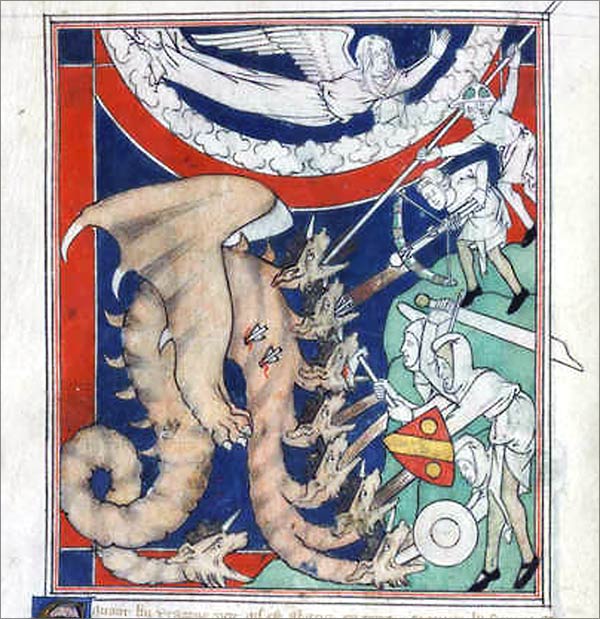
Copyright The Brittish Museum
Here are some other odd birds. One is distinctly a falchion but what happens when it curves the other way??????? :)
Craig
 Attachment: 77.29 KB
Attachment: 77.29 KB
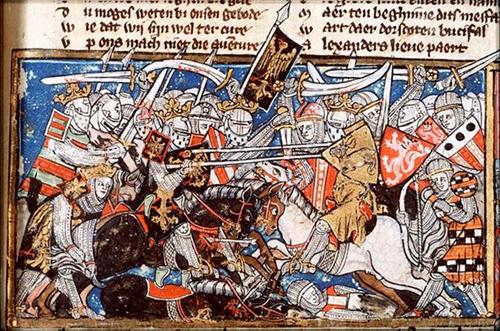
Craig

Nathan,
Thanks for posting the image right on the thread. :D I wasn't sure about doing that.
Yeah, the "short" edge is definitely the cutting edge. It looks as though the back was brought out to a point to allow for a bit of thrusting. Take away the sharp point, and it would look similar to the Conyers Falchion, with it's cleaver-like blade.
I'm always digging around for medieval images to study, and did see this before, but just happened across it again today. It also makes the falchion in the hands of the figure from an Apocalypse of St. John illustrated by Oakeshott in The Archaeology of Weapons look a bit less exaggerated. (This may be from the same manuscript - the British Library lists it as an apocalypse - which might explain the similar falchions.)
Here's the information regarding the image, directly from the British Library:
I think I may be obsessed with this stuff! :D
Falchions are fun! :lol:
Stay safe!
Thanks for posting the image right on the thread. :D I wasn't sure about doing that.
Yeah, the "short" edge is definitely the cutting edge. It looks as though the back was brought out to a point to allow for a bit of thrusting. Take away the sharp point, and it would look similar to the Conyers Falchion, with it's cleaver-like blade.
I'm always digging around for medieval images to study, and did see this before, but just happened across it again today. It also makes the falchion in the hands of the figure from an Apocalypse of St. John illustrated by Oakeshott in The Archaeology of Weapons look a bit less exaggerated. (This may be from the same manuscript - the British Library lists it as an apocalypse - which might explain the similar falchions.)
Here's the information regarding the image, directly from the British Library:
| Quote: |
|
Record Number: c0181-19 Shelfmark: Royal 19 B. XV Page Folio Number: f.22v Description: (Whole folio) Five knights fighting an eight-headed dragon with spear, cross-bow, axe and sword. Above, the woman flying in an inverted arc of cloud. Text below. Title of Work: Apocalypse Author: - Illustrator: - Production: England; early 14th century Language/Script: Anglo-Norman / - All efforts have been made to ensure the accuracy of the information contained in the above description, but the British Library cannot accept responsibility for any errors that may occur. |
I think I may be obsessed with this stuff! :D
Falchions are fun! :lol:
Stay safe!
Hello again!
Craig,
Could the curved swords in the image you posted be an attempt by the illustrator to depict "Saracen" swords? Sometimes they showed curved swords in the hands of "the wicked" or "foreigners" in Medieval art; curved swords sometimes (although not always) seemed to symbolize something evil or exotic. (Of course, Oakeshott showed a drawing of a concave-edged falchion in A Knight and his Weapons.)
Some of those swords in that image have the look of a "knightly" medieval sword (straight, tapered, fullered blade, and cruciform hilt) "bent" in a curve. It could be just a device used by the artist. Of course, the curved swords do seem to be used by knights on both sides, so maybe they are a garbled version of an actual falchion.
Medieval art can be hard to interpret sometimes. Do you have the specifics regarding that image? What is it meant to show? Is it a Biblical, Crusading, or other historical scene?
Neat stuff! I might be able to find several more examples of this sort of thing, especially curved swords in the hands of the "saracens". I'll have to do more digging!
Stay safe, and keep the images coming! :D
| Craig Johnson wrote: |
| Here are some other odd birds. One is distinctly a falchion but what happens when it curves the other way??????? :) |
Craig,
Could the curved swords in the image you posted be an attempt by the illustrator to depict "Saracen" swords? Sometimes they showed curved swords in the hands of "the wicked" or "foreigners" in Medieval art; curved swords sometimes (although not always) seemed to symbolize something evil or exotic. (Of course, Oakeshott showed a drawing of a concave-edged falchion in A Knight and his Weapons.)
Some of those swords in that image have the look of a "knightly" medieval sword (straight, tapered, fullered blade, and cruciform hilt) "bent" in a curve. It could be just a device used by the artist. Of course, the curved swords do seem to be used by knights on both sides, so maybe they are a garbled version of an actual falchion.
Medieval art can be hard to interpret sometimes. Do you have the specifics regarding that image? What is it meant to show? Is it a Biblical, Crusading, or other historical scene?
Neat stuff! I might be able to find several more examples of this sort of thing, especially curved swords in the hands of the "saracens". I'll have to do more digging!
Stay safe, and keep the images coming! :D
Hello again!
Okay, I've found a couple images that show curved swords in the hands of Muslims in two different manuscripts from the British Library. The first is an early-mid 14th century manuscript. Note that the swords carried by the Muslims are rather slim and tapered, sort of like a typical knightly sword bent into a curved sword. The second image is from an early 15th century manuscript. Note that at least one Muslim carries a weapon that's clearly a falchion. It's actually a very nicely depicted falchion of a later style.
Here's the info for the first image, straight from the British Library:
And here's the info about the second image:
 Attachment: 26.32 KB
Attachment: 26.32 KB
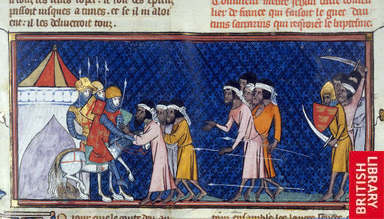
Copyright the British Library
 Attachment: 50.15 KB
Attachment: 50.15 KB
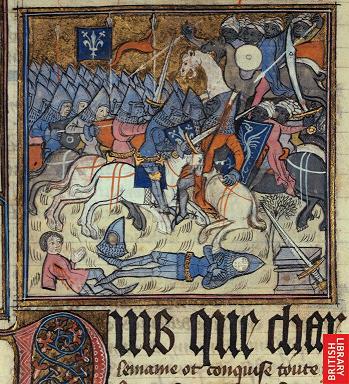
Copyright the British Library
Okay, I've found a couple images that show curved swords in the hands of Muslims in two different manuscripts from the British Library. The first is an early-mid 14th century manuscript. Note that the swords carried by the Muslims are rather slim and tapered, sort of like a typical knightly sword bent into a curved sword. The second image is from an early 15th century manuscript. Note that at least one Muslim carries a weapon that's clearly a falchion. It's actually a very nicely depicted falchion of a later style.
Here's the info for the first image, straight from the British Library:
| Quote: |
|
Record Number: 21762 Shelfmark: Royal 16 G. VI Page Folio Number: f.442 Description: [Miniature only] Treacherous attack by Saracens Title of Work: Chroniques de France ou de Saint Denis, vol. 1 Author: - Illustrator: - Production: France; second quarter of 14th century Language/Script: French / - All efforts have been made to ensure the accuracy of the information contained in the above description, but the British Library cannot accept responsibility for any errors that may occur. |
And here's the info about the second image:
| Quote: |
|
Record Number: 10394 Shelfmark: Add. 15269 Page Folio Number: f.124v Description: [Miniature only] The Crusaders fighting the Saracens Title of Work: Chroniques de France ou de St Denys Author: - Illustrator: - Production: France; early 15th century Language/Script: French / - All efforts have been made to ensure the accuracy of the information contained in the above description, but the British Library cannot accept responsibility for any errors that may occur. |

Copyright the British Library

Copyright the British Library
Hello again!
Here's an actual surviving falchion, apparently in the Musee de l'Armee in Paris, that bears a distinctive resemblance to that shown in the manuscript illumination of the apocalypse. It has the same odd point. This is what was said about it on the site I saw this:
It could be a bit earlier, based on its similarity to the falchion in the manuscript image.
 Attachment: 27.64 KB
Attachment: 27.64 KB

Invalides Falchion
Here's an actual surviving falchion, apparently in the Musee de l'Armee in Paris, that bears a distinctive resemblance to that shown in the manuscript illumination of the apocalypse. It has the same odd point. This is what was said about it on the site I saw this:
| Quote: |
|
A mid-late 14thC falchion with the edge on the convex side in the Musee de l'Armee, Paris. |
It could be a bit earlier, based on its similarity to the falchion in the manuscript image.

Invalides Falchion
Hello Richard
Yes to most of your comments above :) I was thinking the same thing when I saw the recurved blade in the pic I posted, some type of artistic convention. Problem is they do not seem to fit that as they are both depicted in a similar spot and they even have blood on the edges as well as clearly depicted grips and the rest of the swords in picture are all straight. The outsider is often depicted with a curved blade in art but I and several others have surmised this maybe a way to difference the Euro "Knight" from those how are assailing the christian world. There is quite a bit of evidence that the europeans are the ones who introduced the curved sword to some of these cultures.
I think there is a real need to recognize that the early appearance of a type in art is only setting a date that indicates it existed at that point in some form. The straightish curved blade of the messer and the curved clipped point of the falchion are blade styles that I think may well have been seen from some of the earliest periods of steel bladed weapons.
They did not list the site for the pic it is in the gallery here
http://www.fioredeiliberi.org/gallery2/main.php
Best
Craig
Yes to most of your comments above :) I was thinking the same thing when I saw the recurved blade in the pic I posted, some type of artistic convention. Problem is they do not seem to fit that as they are both depicted in a similar spot and they even have blood on the edges as well as clearly depicted grips and the rest of the swords in picture are all straight. The outsider is often depicted with a curved blade in art but I and several others have surmised this maybe a way to difference the Euro "Knight" from those how are assailing the christian world. There is quite a bit of evidence that the europeans are the ones who introduced the curved sword to some of these cultures.
I think there is a real need to recognize that the early appearance of a type in art is only setting a date that indicates it existed at that point in some form. The straightish curved blade of the messer and the curved clipped point of the falchion are blade styles that I think may well have been seen from some of the earliest periods of steel bladed weapons.
They did not list the site for the pic it is in the gallery here
http://www.fioredeiliberi.org/gallery2/main.php
Best
Craig
This topic has been promoted into a Spotlight Topic.
Hello all!
Craig,
As an aside to your comment, I think the curved swords of Central/Eastern Europe don't get the recognition they deserve. I'm not talking later swords, I'm talking earlier medieval curved swords. Many of these were probably influenced by the various steppe cultures that migrated into Hungary and surrounding areas.
In Arms & Armour of the Crusading Era 1050-1350: Western Europe and the Crusader States, David Nicolle has drawings and descriptions of several of these sabres from the 10th-13th centuries. Here's what he said about these swords:
Of course, there's also the "second Sword of Charlemagne" that Oakeshott talks about in The Archaeology of Weapons. Here's what Oakeshott says about the Sword of Charlemagne in the Imperial Treasury in Vienna:
How much influence might these sabres have had on the development of the falchion and messer? Who knows?
I just discovered that some of these were talked about here before. Here's the link to the thread, with lots of nice photos:
http://www.myArmoury.com/talk/viewtopic.php?p=25162
I hope this was of interest!
| Craig Johnson wrote: |
| There is quite a bit of evidence that the europeans are the ones who introduced the curved sword to some of these cultures. |
Craig,
As an aside to your comment, I think the curved swords of Central/Eastern Europe don't get the recognition they deserve. I'm not talking later swords, I'm talking earlier medieval curved swords. Many of these were probably influenced by the various steppe cultures that migrated into Hungary and surrounding areas.
In Arms & Armour of the Crusading Era 1050-1350: Western Europe and the Crusader States, David Nicolle has drawings and descriptions of several of these sabres from the 10th-13th centuries. Here's what he said about these swords:
| David Nicolle wrote: |
|
Sabre from Szekes-Fejervar, Hungary, 10th-11th centuries (National Museum, Budapest, Hungary) This beautiful sabre has a non-tapering blade with an angled tip. In many respects it recalls some fine, and very much later, Japanese swords. The origins of both groups of weapons almost certainly lay in Central Asia. The bulbous quillons are of an unusual and probably early form. Sabre from Esztergom, Hungary, 10th-11th centuries (Museum of Balassa Balint, Esztergom, Hungary) Esztergom, which was founded as a bishopric in the year 1001, is not far from Visegrad, the first capital of Hungary. Not surprisingly, some magnificently decorated weapons have been found in the area, this sabre perhaps being the finest. Curved quillons with bulbous ends...continued to be made for many years, and they were clearly related to those on some of the earliest Islamic sabres. Sabre, Hungary, 11th-12th centuries (replica, Military Museum, Budapest, Hungary) A simpler and probably slightly later weapon still has quillons related to those of the magnificent Esztergom sabre. The blade is, however, of a later form with a broadened tip and angled back, designed to deliver a more powerful blow. Such weapons were characteristic of the Middle East from the 12th century onwards and were presumably developed in response to a wider use of armour. Sabre, Hungary, 11th century (National Museum, Budapest, Hungary) The cultural connection between medieval Hungary, the Turkic nations, and the world of Islam is demonstrated by this sabre. Not only is it a typical weapon of nomadic steppe peoples but its assymetrical quillons and the short sleeve covering part of the blade below them are feature seen, either together or separately, in surviving weapons and art from Western Asia and the Middle East. Sabre, Hungary, 12th-13th centuries (Military Museum, Budapest, Hungary) This was used by one of the Kun, which was the name given to those Turkish Pecheneg tribes which fled into Hungary and then settled there. For several centuries they retained a separate identity and maintained a transhumant pastoral way of life comparable to that of the original Magyars. This long, slender sabre is a typical Turco-Mongol type of weapon, although the uncharacteristically long quillons may be a local development following the Kuns' settlement in Hungary. |
Of course, there's also the "second Sword of Charlemagne" that Oakeshott talks about in The Archaeology of Weapons. Here's what Oakeshott says about the Sword of Charlemagne in the Imperial Treasury in Vienna:
| Ewart Oakeshott wrote: |
|
There is another very splendid sword attributed to Charlemagne in Vienna. Tradition has that it was a present to him from Haroun el Raschid, Caliph of Baghdad, but it is not an oriental weapon in spite of its curved blade and oddly shaped hilt, which are very reminiscent of seventeenth- and eighteenth-century Persian or northern Indian swords; early oriental swords were invariably straight. It is of a type much used in Hungary during the ninth and tenth centuries, a fact proved by the finding of many similar ones in graves of the period. The most similar is from the grave at Tarczal in the Tokay Mountains; this had silver scabbard mounts similar to Charlemagne's but it - or at least the grave - was of a later date (tenth century). It has a slightly curved blade, double-edged to a point a little short of half its length; the cross is short with knobbed ends, made of hollow silver-gilt embossed and chased with arbesque designs; the pommel, in the form of a slightly bulbous cap, is similarly made. The grip is covered with fish-skin and encircled with three jewelled gold bands, later medieval additions... |
How much influence might these sabres have had on the development of the falchion and messer? Who knows?
I just discovered that some of these were talked about here before. Here's the link to the thread, with lots of nice photos:
http://www.myArmoury.com/talk/viewtopic.php?p=25162
I hope this was of interest!
Hello all!
Well, I was able to answer my own question to Craig about the image he posted. I discovered that the image is ultimately from the National Library of the Netherlands. It is manuscript The Hague, KB, KA 20. This is a West Flanders history of circa 1325-1335. The image Craig posted depicts the battle between Alexander and King Porus. And, yes, the manuscript had more interesting images, incuding a more tradional-looking falchion.
The first image if from folio 154r: min. It depicts Lucius dressed as a king and Walewein killing a Roman soldier. Note the falchion amongst the raised swords. It appears to be the reverse of the falchion in the apocalypse image and the Musee de l'Armee; the "beak" of the tip appears to be an extension of the cutting edge.
The next image is from folio 211v: min. It depicts the miracle of the flowering lances and battle between Charlemagne and Agolant. Note the slightly curved sword, and the sword with a "hooked" tip amongst the raised swords to the right.
The last image is from folio 34r: min. It depicts Alexander killing Porus. Note Porus's curved sword. Is it the artists's attempt to depict an "eastern" weapon, or was it something that might have been used in Europe?
 Attachment: 102.61 KB
Attachment: 102.61 KB
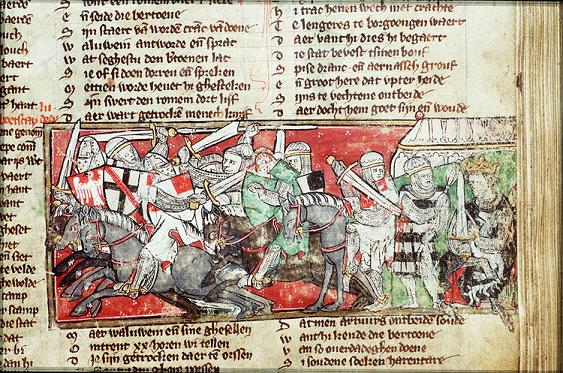
© Koninklijke Bibliotheek National Library of the Netherlands
 Attachment: 101.3 KB
Attachment: 101.3 KB

© Koninklijke Bibliotheek National Library of the Netherlands
 Attachment: 24.52 KB
Attachment: 24.52 KB
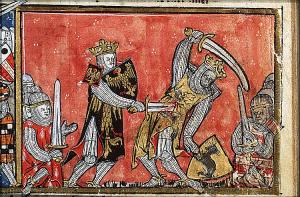
© Koninklijke Bibliotheek National Library of the Netherlands
Well, I was able to answer my own question to Craig about the image he posted. I discovered that the image is ultimately from the National Library of the Netherlands. It is manuscript The Hague, KB, KA 20. This is a West Flanders history of circa 1325-1335. The image Craig posted depicts the battle between Alexander and King Porus. And, yes, the manuscript had more interesting images, incuding a more tradional-looking falchion.
The first image if from folio 154r: min. It depicts Lucius dressed as a king and Walewein killing a Roman soldier. Note the falchion amongst the raised swords. It appears to be the reverse of the falchion in the apocalypse image and the Musee de l'Armee; the "beak" of the tip appears to be an extension of the cutting edge.
The next image is from folio 211v: min. It depicts the miracle of the flowering lances and battle between Charlemagne and Agolant. Note the slightly curved sword, and the sword with a "hooked" tip amongst the raised swords to the right.
The last image is from folio 34r: min. It depicts Alexander killing Porus. Note Porus's curved sword. Is it the artists's attempt to depict an "eastern" weapon, or was it something that might have been used in Europe?

© Koninklijke Bibliotheek National Library of the Netherlands

© Koninklijke Bibliotheek National Library of the Netherlands

© Koninklijke Bibliotheek National Library of the Netherlands
Hello again!
Okay, I found an example of a curved sword, a falchion in this case, being carried by "the wicked" in a medieval manuscript. In this case, it's a falchion being carried by a demon or devil - certainly as wicked as you can get!
Here's the information regarding the manuscript (from the website DScriptorium):
I hope this was of interest!
 Attachment: 43.51 KB
Attachment: 43.51 KB
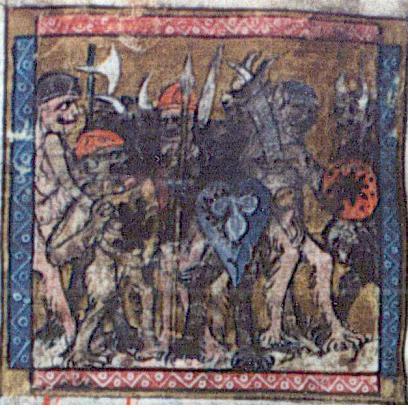
Demon with falchion.
Okay, I found an example of a curved sword, a falchion in this case, being carried by "the wicked" in a medieval manuscript. In this case, it's a falchion being carried by a demon or devil - certainly as wicked as you can get!
Here's the information regarding the manuscript (from the website DScriptorium):
| Quote: |
|
Bibliothèque Municipale de Besançon Ms. [M] 579: Mystere dou jour dou jugement Fol. 26v - L'armée infernale. Diables cornus armés de piques, fourches et de boucliers variés, ornés de crapauds et de chauves-souris. The manuscript of the 14th-century mystery play 'The Day of Judgment,' includes roles for 94 characters, 89 miniatures depicting the action of the play and three neumed musical pieces. |
I hope this was of interest!

Demon with falchion.
Richard, Thanks so much for all of this effort you've been putting into this. Your help is greatly appreciated, along with everyone elses!
It certainly is interesting to see that the falchion and messer are in quite a bit of artwork. Prior to the picture posted here, I've really only seen a handful of depictions of these weapons. Out of simple curiousity, are the artworks here from anyparticular area or all over europe? if they are mainly from several specific parts, that would say that the falchion would have been most prominent in these areas, correct?
On a side note, I am very happy that this has been made into a spotlight topic. Now more people with my original question can have it answered.
It certainly is interesting to see that the falchion and messer are in quite a bit of artwork. Prior to the picture posted here, I've really only seen a handful of depictions of these weapons. Out of simple curiousity, are the artworks here from anyparticular area or all over europe? if they are mainly from several specific parts, that would say that the falchion would have been most prominent in these areas, correct?
On a side note, I am very happy that this has been made into a spotlight topic. Now more people with my original question can have it answered.
Hello all!
Grayson,
I actually tried to give that information whenever possible. The manuscript images I've shown are from England, France, and West Flanders. Some of the images Nicolle referred to included these areas as well as Italy. I am also aware of one on a sculpture of a warrior circa 1345 from the Musee d l'Oeuvre Notre-Dame, Strasbourg. This warrior carries a falchion in a buckled scabbard. This was one I didn't list earlier because it was well into the 14th century, and I wanted to list early depictions of falchions.
I'm glad I could be of help!
Stay safe!
| Grayson C. wrote: |
| Out of simple curiousity, are the artworks here from anyparticular area or all over europe? |
Grayson,
I actually tried to give that information whenever possible. The manuscript images I've shown are from England, France, and West Flanders. Some of the images Nicolle referred to included these areas as well as Italy. I am also aware of one on a sculpture of a warrior circa 1345 from the Musee d l'Oeuvre Notre-Dame, Strasbourg. This warrior carries a falchion in a buckled scabbard. This was one I didn't list earlier because it was well into the 14th century, and I wanted to list early depictions of falchions.
I'm glad I could be of help!
Stay safe!
| Richard Fay wrote: |
| Hello all!
Well, I was able to answer my own question to Craig about the image he posted. I discovered that the image is ultimately from the National Library of the Netherlands. It is manuscript The Hague, KB, KA 20. This is a West Flanders history of circa 1325-1335. The image Craig posted depicts the battle between Alexander and King Porus. And, yes, the manuscript had more interesting images, incuding a more tradional-looking falchion. The first image if from folio 154r: min. It depicts Lucius dressed as a king and Walewein killing a Roman soldier. Note the falchion amongst the raised swords. It appears to be the reverse of the falchion in the apocalypse image and the Musee de l'Armee; the "beak" of the tip appears to be an extension of the cutting edge. The next image is from folio 211v: min. It depicts the miracle of the flowering lances and battle between Charlemagne and Agolant. Note the slightly curved sword, and the sword with a "hooked" tip amongst the raised swords to the right. The last image is from folio 34r: min. It depicts Alexander killing Porus. Note Porus's curved sword. Is it the artists's attempt to depict an "eastern" weapon, or was it something that might have been used in Europe? |
The last picture in this post shows on the right a curved sword held over the head with a very symmetrical looking blade with maybe a central ridge: Now, a heretical thought. :eek: Could the artist be showing movement with the curve or the bending that happens with a thin blade moved and suddenly stopped ? Most of the other examples of falchions shown in the other pics wouldn't conform to this hypothesis and can be seen as true falchions. Just trying to think how a period artist might depict the bending of a sword ! In some ways this reminds me of the type of thing one might see in comic book art where movement is shown by exaggerating bending or motion lines etc ...... Some of this Early Medieval iconography does remind me of cartoons or the way a child might draw rather than the almost " photorealistic " art of the Renaissance.
Anyway, just an idea to consider as a remote possibility in interpreting some period art.
| Jean Thibodeau wrote: |
| The last picture in this post shows on the right a curved sword held over the head with a very symmetrical looking blade with maybe a central ridge: Now, a heretical thought. :eek: Could the artist be showing movement with the curve or the bending that happens with a thin blade moved and suddenly stopped ? |
While on the phone with Craig, he brought up the same possibility. Who is to know?
| Nathan Robinson wrote: | ||
While on the phone with Craig, he brought up the same possibility. Who is to know? |
When the blade profile is of some type of clip point or expands i.e. become wider near the point and may also have a curved blade we can be reasonably certain that the artist was intending to make it look like something he saw or knew about. It may be possible that it's artistic license but when it shows up at various time periods by different artists and some written sources speak of falchions the " proof " seem reliable.
With a drawing that looks like a double edged sword in all ways normal except for the curve of the blade we have to at least wonder. :eek:
It is kind of flattering and pleasing that Craig brought up the same possibility. :cool:
Hello all!
Curved swords as a way to show movement, or the bending of swords in movement? That's an interesting idea! There are some manuscripts images, however (like the Treacherous attack by Saracens from the Chroniques de France ou de Saint Denis, vol. 1) that seem to show curved swords only in the hands of the "Saracens". In these instances, there does seem to be a foreign or exotic symbolism attached to the swords. There are always examples that refute this, but its hard to know what went on in the illuminator's mind. Remember, most illuminators were monks; many would not necessarily have known what a sword in action would have looked like. There are, again, exceptions to this, the Maciejowski Bible perhaps being one (the illustrations seem to have been made by someone who knew the details of military equipment).
I was going to bring up the possibility of a connection between the kopis and falcata with the falchion (as per, perhaps, Hewitt), but I noticed this thread:
http://www.myArmoury.com/talk/viewtopic.php?t=2729
Might you be able to add the falchion and messer to Kirk Lee Spencer's "Possible Line of Development From Pole Axe to khopesh to Kopis to Seax to Viking"?
Curved swords as a way to show movement, or the bending of swords in movement? That's an interesting idea! There are some manuscripts images, however (like the Treacherous attack by Saracens from the Chroniques de France ou de Saint Denis, vol. 1) that seem to show curved swords only in the hands of the "Saracens". In these instances, there does seem to be a foreign or exotic symbolism attached to the swords. There are always examples that refute this, but its hard to know what went on in the illuminator's mind. Remember, most illuminators were monks; many would not necessarily have known what a sword in action would have looked like. There are, again, exceptions to this, the Maciejowski Bible perhaps being one (the illustrations seem to have been made by someone who knew the details of military equipment).
I was going to bring up the possibility of a connection between the kopis and falcata with the falchion (as per, perhaps, Hewitt), but I noticed this thread:
http://www.myArmoury.com/talk/viewtopic.php?t=2729
Might you be able to add the falchion and messer to Kirk Lee Spencer's "Possible Line of Development From Pole Axe to khopesh to Kopis to Seax to Viking"?
Page 2 of 3
You cannot post new topics in this forumYou cannot reply to topics in this forum
You cannot edit your posts in this forum
You cannot delete your posts in this forum
You cannot vote in polls in this forum
You cannot attach files in this forum
You can download files in this forum
All contents © Copyright 2003-2006 myArmoury.com — All rights reserved
Discussion forums powered by phpBB © The phpBB Group
Switch to the Full-featured Version of the forum
Discussion forums powered by phpBB © The phpBB Group
Switch to the Full-featured Version of the forum